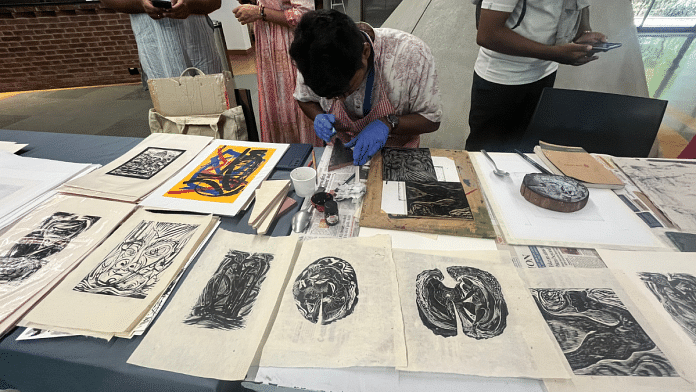During the 2019 anti-CAA protests, Aziz’s Sab yaad rakha jayega (Everything will be remembered) echoed on the streets. In May that year, he also released the song Ballad of Pehlu Khan on the mob lynching of the 55-year-old dairy farmer from Haryana.
Sab yaad rakha jayega was recited, in English, by Pink Floyd guitarist Roger Waters in a 2020 protest in London against the arrest of Wikileaks founder Julian Assange. Aziz had found his voice, his oeuvre, and a place in the hearts of many, including artist and first woman curator of the Kochi-Muziris Biennale, Anita Dube.
In 2023, Dube came up with a set of four works carrying excerpts from Aziz’s poem. They were on exhibition and available for sale from 15 March to 19 April 2025 at the Vadehra Art Gallery in New Delhi. As there were no wall captions, no credit was given to Aziz. Dube had used another poem by Aziz in an earlier work, Intifada, which was exhibited in Delhi and Mumbai.
When Aziz got to know that his work was borrowed without his “knowledge, consent, credit or compensation”, he posted on Instagram, calling it “theft”.
“This is my poem, written in velvet cloth, hung inside a commercial white cube space, renamed, rebranded, and resold at an enormous price without ever telling me,” the poet wrote. He added that it was not “conceptual borrowing”, but “the entitled section of the art world doing what it does best, extracting, consuming, profiting while pretending it’s radical.” For Aziz, it was ironic that while his poem raged against injustice, Dube, by commodifying it, extended the injustice.
In her defence, Dube claimed that she used Aziz’s lines with clean intent, as an act of celebrating them. She added that she has also quoted Martin Luther King and bell hooks in the past “in the same spirit”.
Using someone’s work as inspiration as against structure are two different things. In response to the famous copyright dispute in the US involving a portrait of American singer Prince, Columbia Law School professor Timothy Wu said, “If the underlying art is recognisable in the new art, then you have got a problem.” Dube’s act, by this measure, is problematic.
In academic writing, to lift even an idea without adequately crediting the source is considered plagiarism. Here, stanzas were taken in an unauthorised manner.
Copyright is possible only for original work and automatically belongs to the author. For using such copyrighted work, you need a licence, you need to give credit to the creator, and share remuneration. And when the intentions are clean, none of this can happen post facto. Dube clarified that she had credited Aziz, in an accompanying sheet available at the gallery, but admitted that no permission had been taken.
Here, the moral rights of the creator come into play. Moral rights, also called the right of attribution, require that the name of the author must always be displayed with the work. The author has this right even if they choose to remain anonymous or use a pseudonym. These rights are inherent and cannot be sold or assigned, but can be acknowledged via permission and credit, and used as pre-determined terms.
All this has to be ensured before the derivative work goes public. They can also be waived in whole or in part as per the protocol of exceptions. However, Aziz’s work was not in the space of exceptions, although he has created a special exception for this particular poem—a political protest anywhere can have placards saying Sab yaad rakha jayega.
Behind Dube’s use of Aziz’s poem is possibly the tradition of borrowing, including replications and repurposing elements from previous works or styles. According to art consultant and author Anupa Mehta, “In postmodernist art, artists draw from eclectic sources. Sometimes these ‘borrowings’ are in part and used within an art work, as part of its conceptual axis. Usually, source is acknowledged. If the poet’s poem is used in full without permission and sans royalty, it’s clearly a breach”.
Mehta suggested that the issue of copyright in the art world needs to be looked at on a case by case basis, creating space for a more nuanced reading. It begs several questions. “Was it a creative collaboration? Were terms clarified prior?
Artists often work with artisans, craftspeople, and younger artists. Should drawing upon another creative person’s skills be considered a contribution to the artwork? For instance, artist Bharti Kher employs women to fill in bindis in her paintings. These women are paid a per diem, while Kher’s works sell for high prices. Similarly, artist Binoy Varghese hires young artists to fill in paint on his canvases. Should those strokes be protected by copyright?
“It’s not all as straightforward as it should be,” said Mehta.
Art curator Alka Pande found the allegation of “theft” against Dube too strong. “Even the best writers are inspired by the work done before them. These are opaque, porous borders,” she said.
Pande described Dube’s work as part of a creative process where activism, propaganda, and politics coalesce. However, she added that due credit must be given and the collaborative process should be acknowledged. “If there is a financial aspect to the work, then the financials should be clear with the collaborating parties.” That, precisely, is the problem in Aziz’s case.
We know that post-colonial “borrowings” of cultural and material expression were, in effect, a continued resistance to colonial and neo-colonial hegemony, and that resistance must be relentless. While the past undoubtedly continues to shape the present, dominant meta-narratives are being resisted, and the local prioritised. Aziz’s work represents this evolving idea of decolonising. Dube may well have intended her work as part of that arc, but it has ended up reading as contrarian.
Even if we use the relatively neutral term ‘borrowing’, the nature of such borrowings must be examined in today’s context. In borrowing Aziz’s poem, which calls for fighting injustice, we see how injustice itself can be perpetuated. In a twisted way, it echoes Homi K Bhabha’s theory of mimicry, where the adoption of the coloniser’s language simultaneously subverted colonial power and the self.
Borrowings may show the mirror to the world, but today, ethical lines are more clearly drawn. Ethical protocols now distinguish borrowing from appropriation. In a neo-capitalist context, the sharp power imbalance between a hounded protest poet and an established artist selling work based on his angst-ridden poetry—without acknowledgement—can nullify even the best of intentions. The concept of borrowings, especially in this globalised, nationalist moment, must be revisited. The silver lining in this misadventure is that it opens space for reflection, self-criticism, and a deeper dive into copyright, plagiarism, and the exceptions that govern them.
When ideas are copied without attribution and no direct financial gain is sought, it qualifies as plagiarism. This often occurs in academia. Direct quotations from earlier work must be properly cited using established norms. Even paraphrased ideas require credit. An insufficient citation is also plagiarism. Notably, plagiarism can be identified not just by the original author but by a third party.
Copyright, by contrast, protects original work—written, musical, dramatic, or visual. Once created, a work is protected by default, though formal registration offers added protection. Copyright grants creators exclusive rights to control how their work is used, copied, translated, distributed, adapted, incorporated into other works, or monetised. Some exceptions exist: fair use, Creative Commons, and copyleft.
Fair use is a high-ethics space. It allows work to be used strictly for purposes like teaching, journalism, and public analysis. It’s a balancing act between the author’s rights and public interest—never a free-for-all.
Creative Commons licenses allow authors to waive some rights (often monetary) in exchange for credit and acknowledgement. Wikimedia Commons is a well-known example.
Copyleft is a more altruistic approach. It allows anyone to use, improve, or build on a work—so long as the derivative is shared on the same terms. This model is widely used in software.
None of these exemptions apply in the case of Aziz and Dube. As things stand, Dube has apologised, withdrawn those works from all platforms of exhibition, distribution, and sale “in the future and in perpetuity”. She has offered the artwork Intifada to the poet “with full ownership rights as compensation and as a gesture of reconciliation”. All attempts at financial settlement have so far reached a dead end.
In fact, a unilateral post facto financial offer can be a double whammy. Only the original author—or an authority the author designates—can agree to a post-facto settlement. In searching for resolution, intent matters. And two principles must anchor this process: that no solution can be one-sided, and that the final word belongs to the wronged party—unless ruled otherwise by a court.
Arshiya Sethi is a two-time Fulbright Fellow, dance scholar, researcher and ‘artivist’, supporting management of arts institutions in creating inclusive and safe practices. Views are personal.
(Edited by Aamaan Alam Khan)








